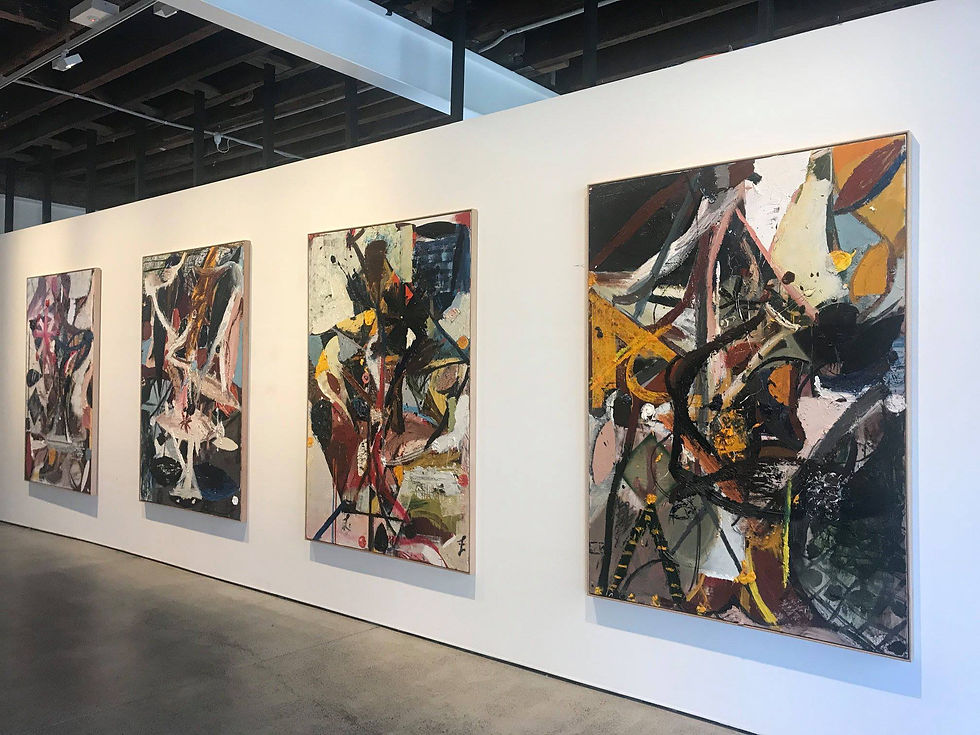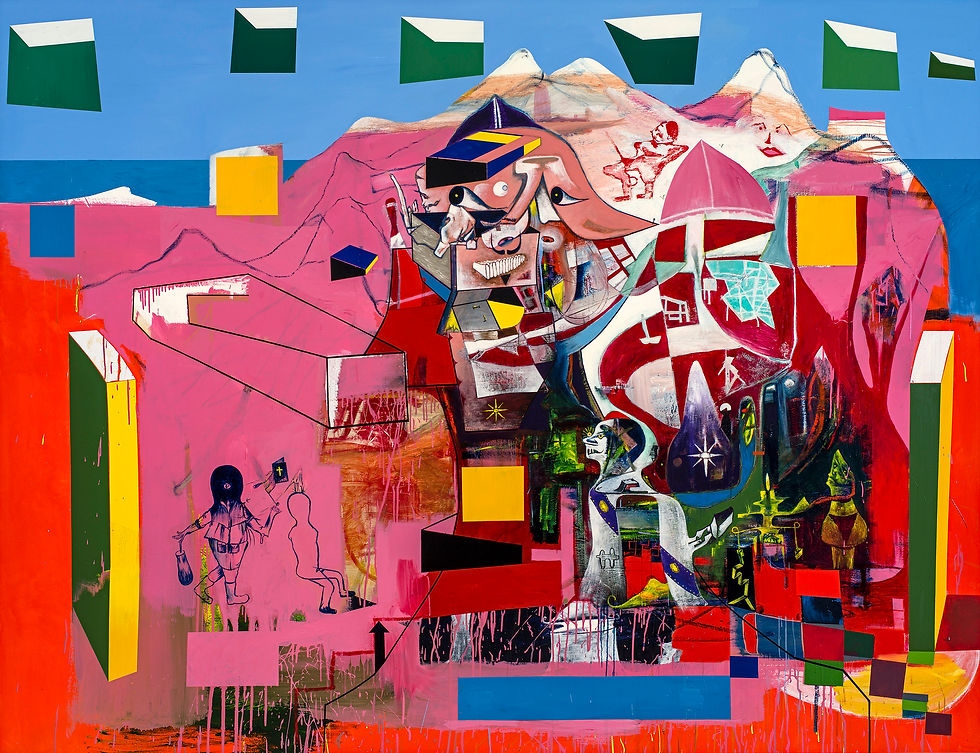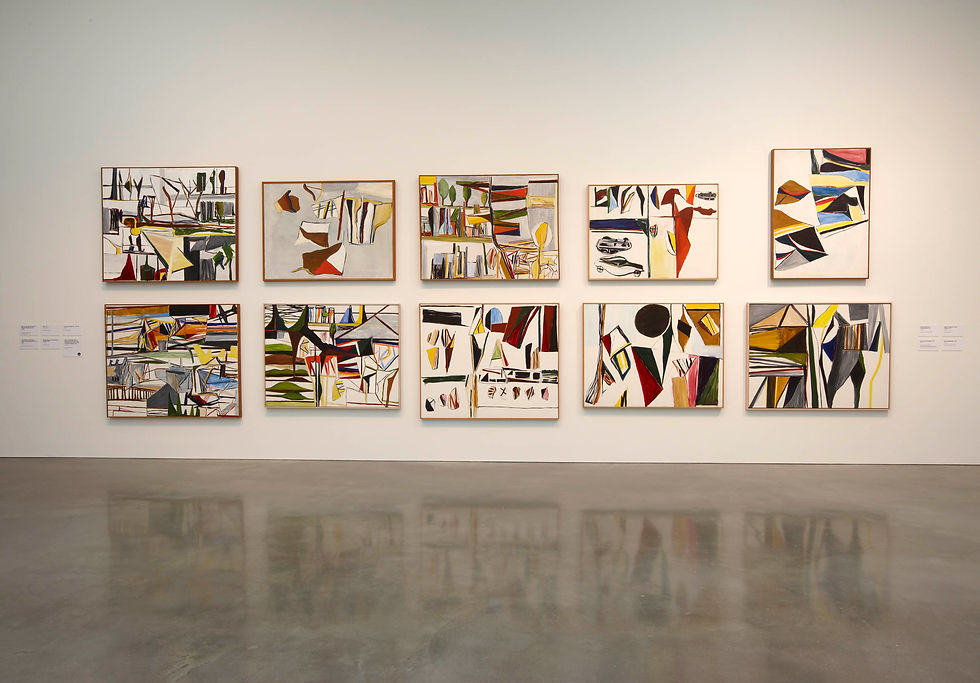A diagram of the thinking mind: The radical art of James Drinkwater, Ken Whisson and Gareth Sansom
- Andrew McIlroy
- Oct 18, 2018
- 4 min read

The paintings of Australian artist James Drinkwater are hard to define. But this is anything but a problem. Despite their gestural intricacy and vibrancy, the often large-scale, individualistic works are immediately accessible. Indeed, one is compelled to enter the picture, to follow the artist’s marks in an attempt to unravel his thinking.
Equally the influences on this remarkable, widely-travelled artist are hard to define. Drinkwater’s imagery comes together in his works in a phantasmagoria – a sequence of radical imaginings drawn from deep inside his emotional being. This intensity of thought is evident watching him work paint onto a canvas, intuitively working the paint reinventing his own observations and memories. And the combined result in both landscape and figurative form is powerful, separating this artist from many of his contemporaries who strive towards abstract expressionism only to fall short.

James Drinkwater with Wendy Whiteley on winning the 2014 Brett Whiteley Travelling Scholarship Photo: Financial Review
Writing in the Financial Review (20/01/20017) art critic John McDonald lauds Drinkwater’s ability to reinvent the landscape, without distracting from its authenticity,
Painter Fred Williams pointed out that in the Australian landscape there's no obvious focal point, which means an artist had to build such features into a painting. Drinkwater is quick to agree. "What I love about the Australian landscape is that it's disorderly, it's prickly and tough. In my paintings I want to capture that landscape from multiple perspectives. I want a sense of vitality and energy – that strong gesture.
Although his paintings may seem dauntingly abstract at first glance, Drinkwater recognises that in today's art world he could be viewed as old-fashioned. By his own admission, as a gestural painter he is "a bit of a dinosaur", but he loves paint too much to worry about whether he is in or out of fashion. What's important is the spirit of the picture rather than the medium.
"A lot of artists are responding to these terrible times with works full of terror and sadness," he says. "I'm doing the opposite – offering some respite."

Installation view of James Drinkwater's 2018 Sydney exhibition at Nanda\Hobbs Photo: Nanda\Hobbs
In this Drinkwater’s reconciles his Humanist approach with the genre of abstraction, more often seen as in conflict. Drinkwater’s paintings are human-centred and rational on the one hand, brought to the fore by his masterly handling of paint and space. On the other hand, Drinkwater’s paintings defining feature, elusive until now, is found in their radical, rather than reactionary, commitment to form.
In this combined way, Drinkwater's prominent position at the forefront of his generation of artists, breathing new life into Expression, is well deserved - joining senior artists today like Gareth Sansom (b1939) and Ken Whisson (b1927), who similarly have impacted upon their respective generations. These artists draw upon imaginings, and fantasies, building - adding to and taking away from - their painted vistas to a form that reveals much more than is found in their natural state.

Gareth Sansom, A universal timeless allegory, 2014 Photo: NGV

Installation view of Ken Whisson exhibition at Niagara Galleries in 2002 Photo: Niagara Galleries
Whisson gives voice to this ambition,
I believe that the reason for making art is that it gives to the world, not just to human beings, some more profound dimension, something nearer to the reality that we feel it surely must have, but does not seem to have.
Whisson’s uncompromising career spans over 70 years, and has been built around his dedication to the acts of painting and drawing, and a enduring fascination with the delicate operations of both his inner reality and the world at large. (Museum of Contemporary Art, September 2002)
The parallels with Drinkwater for me are striking.

Ken Whisson, Factory Poplar Trees and Red Brick Church, 1994-96
McDonald writing for Whisson’s 2001 solo exhibition at Melbourne’s Niagara Galleries surveys the collected works,
Looking at one of Ken Whisson's works is like studying a diagram of the thinking mind. This is why their schematic forms begin to seem ever more familiar over time – they conjure up experiences and observations that virtually everyone holds in common.”
Ken Whisson's paintings are intuitive sketches, marks and notations of things seen and experienced. Observational references are often obscured by abstract forms; lines and shapes, anamorphic or otherwise, create suggestive passages of painting. Whisson's work is akin to an expanded form of writing: he spells out images, creating rudimentary symbols, these forms working together to record an accurate reflection of the artist's memory.
John McDonald, Ken Whisson: Paintings and Drawings 1947-1999 with Writings and Talks by the Artist, Niagara Publishing, Melbourne, 2001
Like Whisson and Sansom, Drinkwater’s towering, intricate paintings, spurning the notion of fixed ideas and unbending technique, transfix and chip away at the viewer. The imagery is there. Stoic. Fantastical yet familiar. While Drinkwater achieves much that is new, incisive and technically adept with his latest paintings on display at Sydney’s Nanda\Hobbs Gallery, the artist owes much to those abstract expressionists who came before, laid bare too their personal journeys, and similarly refused to compromise.

James Drinkwater, Arriving in the East End, 2018 Photo: Nanda\Hobbs




Comments